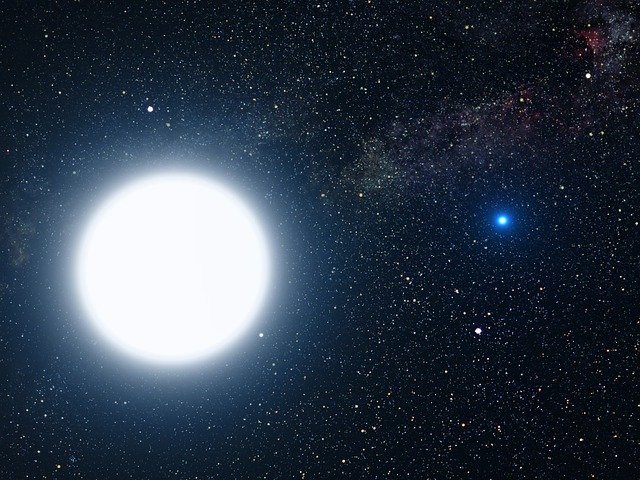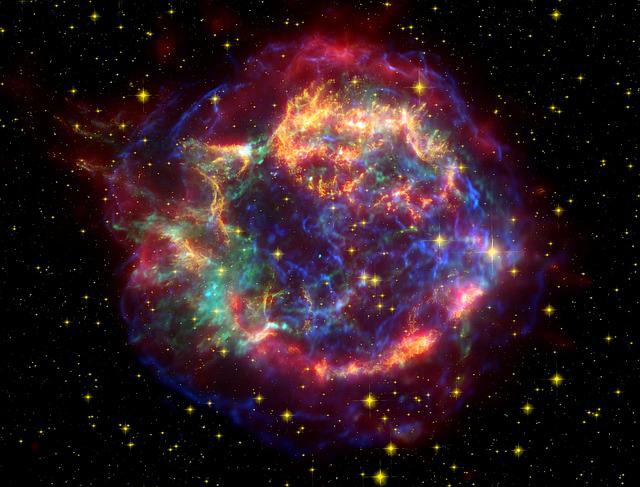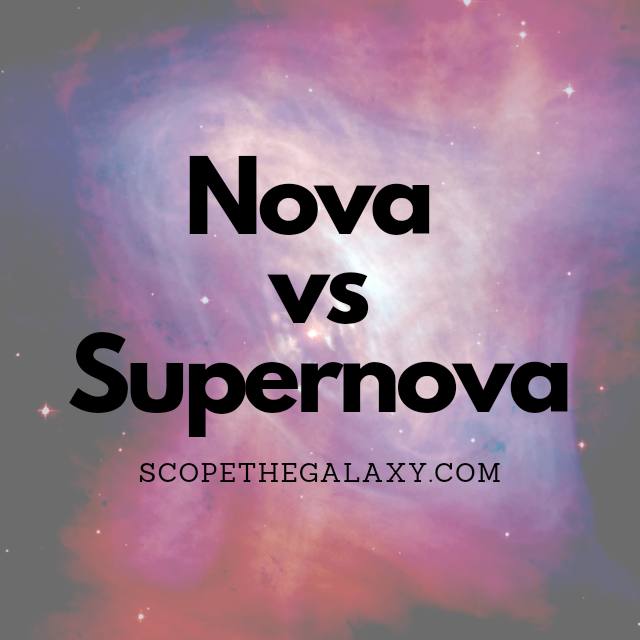*This post may contain affiliate links. This means we may make a commission if you purchase an item using one of our links*
The main difference between novas and supernovae is that a nova explosion only transpires on the surface of white dwarfs when an abundance of hydrogen is gathered from a companion red giant. In contrast, a supernova is a grandiose explosion brighter than most galaxies that only happens when a larger star or a 1.44 solar mass white dwarf dies.
This is just the main surface level difference between both explosions. Continue reading if you wish to learn more about how a nova and supernova function along with the other differences between the two.
What Is A Nova?
Table of Contents

A nova will occur when a white dwarf consumes too much energy from its binary companion star. This causes nuclear fusion on the white dwarfs surface, momentarily inducing a very bright energy outburst on the stellar remnant’s exterior.
When the surface of a white dwarf heats up to around 20,000 degrees Celsius the nuclear fusion process will activate, allowing it to act as if it were the core of an active star again.
The energy produced is significant, where it ejects resources in the region of 100,000 times more powerful than the white dwarfs typical cycle.
This excess energy needs to be ejected out otherwise it wouldn’t be able to conserve its form. That’s why the exterior explodes creating what we now refer to as a nova explosion, an explosion that has been observed to increase in brightness over the course of a few months.
Some white dwarfs tend to have nova outbursts a few times a century, while others are rarer. Ultimately for the explosion to occur, it will depend on how much hydrogen can be provided by a white dwarfs red giant companion star.
Although not the most commonly observed cosmic activity, scientists often find roughly 40 new novas every year in the Milky Way, which does imply that billions of nova explosions likely happen every year throughout the cosmos.
What Is A Supernova?

Black holes and neutron stars are what remains after a supernova explosion occurs, which in turn means that this explosion is the process followed when a star dies. It will then be classified as a type 1 supernova if it leaves no hydrogen line emissions in the spectra and would be type 2 if it does produce hydrogen line emissions when a star dies.
There are two ways that a supernova explosion can form.
It can either be via a white dwarf in a binary star system that accumulates too much energy from its companion star causing it to explode or when a larger star runs out of nuclear fuel and collapses under its own gravity, leaving behind the bright and grandiose remnants of this explosion many times brighter than even its own galaxy.
As stated above supernovae are generally split into 2 types, a type 1 supernova or a type 2. Type 1’s are then further split into 1 of 3 subcategories, whether Ia, Ib, or Ic.
A type 1a supernova is the most commonly observed in outer space and acts like a candlelight to help us observe distance across the deep unknown.
These are theorised to form after a white dwarf, likely in a binary star system, exploding due to the overconsumption of energy from its companion. Type Ia’s have a strong silicon absorption line near its maximum luminosity whilst producing no hydrogen at the same time
Type Ib’s are formed after a large star collapses under its own core gravity where the outer region of the star’s hydrogen is stripped away, leaving behind only the second layer of helium.
Type Ic’s lack both the hydrogen and helium layer when they explode, although the difference here has been debated as not being significant enough to differentiate a type Ib from a Ic.
Type 2 supernovae are formed when a star between 8 – 50 times the Sun’s mass collapses into itself and causes a huge explosion either producing a neutron or a black hole if the materials left behind exceed 3 – 4 solar masses.
In essence, anything above 20 times the size of our Sun can potentially result in a black hole whilst a star that is 1.44 solar masses or between 10 – 20 times the mass of our Sun would produce a neutron star instead.
Is A Supernova Brighter Than A Nova?
Yes, Supernovae are amongst the brightest phenomena in the universe with only quasars and the much grander hypernova explosions eclipsing them in this regard.
They’re able to outshine entire galaxies, even if it is for a relatively short period in the expansive cosmos. Novas, on the other hand, are bright flares or outbursts that occur on the surface of a white dwarf, 100,000 times than that of the sun but, this is far inferior to the power, energy, and brightness that an entire star exploding would produce.
Therefore, the brightness levels between the are not really comparable, even if novas are on the brighter end for a celestial phenomena throughout the cosmos.
Similarities Between A Nova And Supernova
Type 1 supernovae require a white dwarf and a companion star to transpire, so both a nova and a type 1 supernova need a red giant to materialize.
Both are short outbursts of brightness that occur over a short period of time, with one obviously much bigger and brighter than the other. Other than this, there isn’t much else similar between the two.
Differences Between A Nova And Supernova
In regards to the differences between a nova and a supernova, it includes the following:
- Novas are outbursts of energy on a white dwarfs surface after they’ve accumulated too much energy whereas a supernova is a grandiose explosion that occurs once a larger star or even a white dwarf that’s consumed too much energy collapses into itself leaving behind either a neutron star or black hole.
- Supernova explosions can produce heat in the region of 1 billion degrees celsius whilst novas are around 20 million degrees celsius.
- 1 supernova explosion occurs every 50 years within the Milky Way whereas 40+ nova explosions tend to happen every year in our galaxy.
- Supernova can produce luminosity that is brighter than that of entire galaxies whilst nova explosions only produce the brightness of 100,0000 Suns. Although bright this simply does not hold a candle to the power of a supernova.
- Supernovae explosions will be much larger than a nova in size taking into account the explosion encompasses an entire star’s death as opposed to a small portion of a white dwarfs surface.
Summary
Novas are bright and luminous explosions in their own right but, comparing it to a supernova which is the process larger stars and white dwarfs go through when they collapse into themselves and die, it doesn’t really hold up when you consider nova are just small explosions on the surface of a relatively small dead star.
Both can last a few months but supernova are far rarer as one takes place in the Milky Way every 50 years as opposed to the roughly 40 nova explosions that happen per year in the Milky Way.


